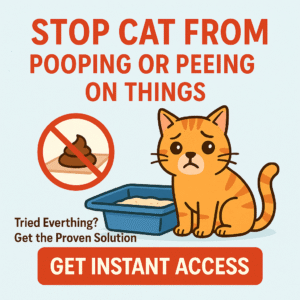When your cat starts peeing in one corner of your home, it’s rarely about rebellion. This behavior usually signals health issues, stress, or confusion around their litter box. In this guide, you’ll uncover the root cause, implement proven fixes, and restore comfort and cleanliness for both you and your feline companion.
The Cat Spray No More ebook offers clear routines, tracking tools, and cleaning strategies that align perfectly with this process—helping you prevent repeat accidents and build a stress-free environment.
Why Is Your Cat Peeing in One Corner?
Quick answer: Persistent corner peeing often stems from medical discomfort, litter box dissatisfaction, or emotional stress. It’s a communication tool—not defiance. Your cat is telling you something needs attention.
1. Medical Issues—Always Start with a Vet
- Urinary tract infections (UTIs) and bladder inflammation can make using the litter box painful.
- Urinary crystals or stones irritate the bladder wall and cause avoidance of the box.
- Diabetes or kidney disease may bring increased urination urgency.
- Arthritis or joint pain can make entering or exiting the litter box difficult.
Action step: Schedule a vet appointment with urinalysis and blood tests. Accurate diagnosis and treatment often resolve peeing issues quickly.
2. Accident vs Territorial Marking
| Accident | Marking (Spraying) |
|---|---|
| Horizontal corner, tail down posture, normal volume | Vertical edges, tail up/twitching, very small amount |
If it’s marking, spay/neuter and reduce stress triggers. If it’s accidental, focus on comfort, cleanliness, and confidence.
3. Litter Box: Setup & Comfort Check
- Use one box per cat plus one extra—spread across different areas.
- Scoop daily and deep clean weekly using unscented soap.
- Choose large, open-top boxes with fine-grain, unscented litter.
- Place boxes in quiet, low-traffic zones away from noise or appliances.
Make sure your cat can enter and exit without jumping or hesitation.
4. Stress & Environmental Factors
- New pets, guests, or construction noise can prompt anxiety.
- Outdoor animals visible through windows trigger stalking or marking behavior.
- Routine interruptions—feeding times, cleaning schedules—cause insecurity.
What helps: Use pheromone diffusers like Feliway in problem zones, create safe hiding spots and vertical perches, and maintain consistent routines.
5. Deep Cleaning That Actually Works
- Use enzyme-based cleaners designed to eliminate urine odor at the molecular level.
- Apply liberally until the area stays damp for 10 minutes.
- Allow it to air-dry completely—don’t use heat.
- After drying, add a washable mat or barrier while tracking progress.
6. Redirect, Reward, Repeat
- Keep an eye out for corner-approach behavior and calmly guide your cat to the litter box.
- When they use the box, reward them immediately with gentle praise or a small treat.
- Ignore accidents—avoid scolding, which can increase stress and worsen behavior.
7. Enrichment & Environment Support
- Add vertical perches, scratching posts, and cozy hiding places near problem areas.
- Provide puzzle feeders and interactive playtime daily to reduce idle stress.
- Offer a quiet feeding or bedding area away from the litter box.
8. Logging, Routine & Structure
The Cat Spray No More ebook includes structured tracking tools that help you:
- Log accidents—notes on time, location, and context reveal triggers.
- Create cleaning schedules for box maintenance and odor elimination.
- Build routines for feeding, play, grooming, and litter checks.
9. When to Call for Help
- If peeing continues after 14 days of consistent intervention.
- If you suspect marking behavior despite spaying/neutering.
- If medical or mobility concerns persist.
- If multi-cat dynamics or stress remain unresolved.
In these cases, consult a certified behaviorist or veterinary behavior specialist for tailored solutions.
Real-Life Turnaround: One Owner’s Story
“After adopting a second cat, Luna began peeing in the living room corner. A vet visit cleared medical issues. We deep-cleaned the area with enzyme spray, added a new litter box in the same room, installed a Feliway diffuser nearby, and followed the ebook’s tracking sheets to note her habits. Within a week, the accidents stopped entirely—and our home feels calm again.”
14-Day “Corner Peeing Rescue Plan”
| Days | Focus Area | Actions |
|---|---|---|
| 1–2 | Vet Check & Cleaning | Vet visit, deep-clean the corner with enzyme cleaner, install interim barrier |
| 3–5 | Litter Box Setup | Add one extra open, large box nearby, use new litter, clean daily |
| 6–9 | Stress Reduction | Place pheromone diffuser, add perch or hiding spot, maintain strict routine |
| 10–14 | Redirect & Reward | Catch mistakes, gently move to box, reward usage, track incidents |
| 15+ | Maintenance & Review | Continue logs weekly, deep clean monthly, consider behavior consultation if needed |
What Success Looks Like
- Week 1: Noticeable decrease in corner accidents.
- Week 2–4: Regular litter box usage replaces corner attempts.
- 1–2 months: Corner accidents eliminated, established routines.
- 3+ months: Stable habits, confident cat, no new issues.
Conclusion: Compassion, Structure, Confidence
Corner peeing is not rebellion—it’s a cause-and-effect reaction to discomfort or confusion. With a methodical approach—vet care, clean environment, enriched spaces, routine structure, and positive cues—you can help your cat feel safe and in control.
The Cat Spray No More ebook gives you the full system—tracking logs, cleaning blueprints, environment checklists, and behavioral tools—to resolve peeing problems and prevent recurrence.
Download Cat Spray No More now and steer your cat away from corners and toward confidence—together.
